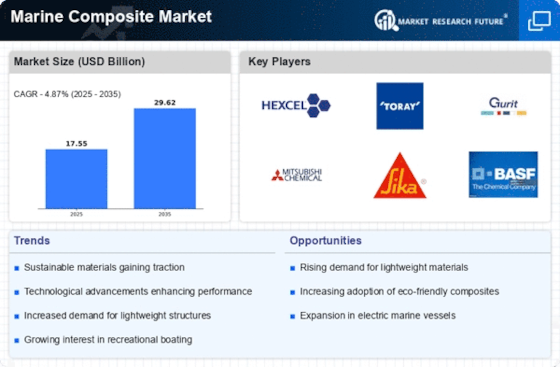Innovations in Composite Manufacturing
Innovations in manufacturing processes are playing a crucial role in the Marine Composite Market. Advanced techniques such as automated fiber placement and 3D printing are enhancing the efficiency and precision of composite production. These innovations not only reduce production costs but also improve the quality and performance of marine composites. For instance, the introduction of new resin systems has led to composites that are more resistant to environmental degradation, thereby extending the lifespan of marine vessels. Furthermore, the market is witnessing a shift towards more sustainable manufacturing practices, which aligns with the growing emphasis on environmental responsibility. As these technologies continue to evolve, they are expected to drive further growth in the Marine Composite Market.
Environmental Regulations and Standards
The Marine Composite Market is increasingly influenced by stringent environmental regulations and standards aimed at reducing the ecological impact of marine activities. Governments are implementing policies that promote the use of sustainable materials and practices in boat manufacturing and maintenance. These regulations often encourage the adoption of composites, which can be designed to be more environmentally friendly compared to traditional materials. For instance, the use of bio-based resins in composite production is gaining traction as manufacturers seek to comply with environmental standards. As these regulations become more prevalent, they are likely to drive innovation and investment in the Marine Composite Market, as companies strive to meet compliance while also appealing to environmentally conscious consumers.
Rising Demand for Lightweight Materials
The Marine Composite Market is experiencing a notable increase in demand for lightweight materials, driven by the need for enhanced fuel efficiency and performance in marine vessels. Composites, such as fiberglass and carbon fiber, offer significant weight reductions compared to traditional materials like steel and aluminum. This shift is particularly evident in the recreational boating sector, where manufacturers are increasingly adopting composite materials to improve speed and maneuverability. According to recent data, the use of composites in boat manufacturing has grown by approximately 15% over the past few years. As consumers become more environmentally conscious, the demand for lightweight, fuel-efficient vessels is likely to continue to rise, further propelling the Marine Composite Market forward.
Growing Popularity of Recreational Boating
The Marine Composite Market is witnessing a surge in the popularity of recreational boating, which is driving demand for composite materials. As more individuals seek leisure activities on the water, the market for boats and personal watercraft is expanding. Composites are favored in this sector due to their lightweight properties, which enhance performance and fuel efficiency. Recent statistics indicate that the recreational boating market has grown by approximately 10% annually, with a significant portion of new vessels being constructed using composite materials. This trend is expected to continue as manufacturers innovate and develop new designs that appeal to consumers. Consequently, the Marine Composite Market is likely to see sustained growth as the recreational boating sector flourishes.
Increasing Investment in Marine Infrastructure
The Marine Composite Market is benefiting from increasing investments in marine infrastructure, including ports, shipyards, and recreational facilities. Governments and private entities are recognizing the importance of modernizing marine infrastructure to support economic growth and enhance maritime safety. This trend is reflected in various initiatives aimed at upgrading existing facilities and constructing new ones, which often incorporate advanced composite materials for their durability and resistance to corrosion. For example, the construction of new docks and piers using composite materials is becoming more prevalent, as these materials offer longer service life and lower maintenance costs. As investments in marine infrastructure continue to rise, the demand for composites in construction and maintenance is likely to expand, positively impacting the Marine Composite Market.


















Leave a Comment